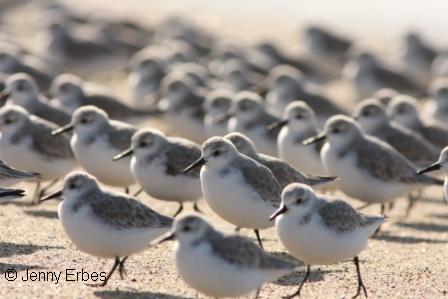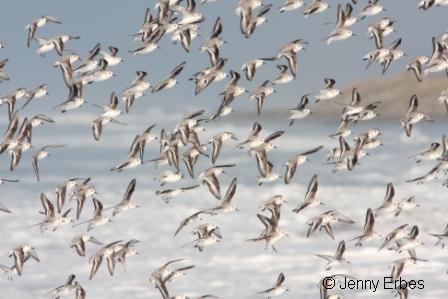The sanderlings or Calidris alba are the cute little birds obsessively running in and out with the tide.
Sanderlings are pretty small, averaging 7.5 inches in length and weighing about 2.5 ounces. Females and males look alike with soft black eyes, dark black legs and feet, light gray feathers on the back and head, bright white feathers on their bellies and a good-sized sturdy black bill.
Rest assured their running serves a purpose—catching breakfast, lunch and dinner. According to the Birds of North America database, sanderlings dine on tiny hippid crabs, beach bugs that burrow in the sand and little mollusks. As the waves roll in sanderlings run up the beach and as soon as the waves recede they run back prodding the sand with their stout bills searching for food.
This diet has an interesting ramification: pellets.
As described in the Birds of North America database, “Beach-foraging sanderlings in California commonly regurgitate pellets, especially while roosting. Pellets are cohesive, prolate spheroids composed of sand embedded with fragments of crustacean and mollusk shells.”
This means that when sanderlings are resting or at least not running, they are coughing up small football shaped bits of indigestible material. But is it possible that a sanderling’s zany eating habits display signs of something deeper, something psychological?
Are sanderlings consciously aware that they have almost been banished from the Scolopacidae family, which includes sandpipers and many other shorebirds? According to The Sibley Guide to Bird Life & Behavior, all the birds within the scientific Family Scolopacidae have an “elevated hind toe.” Except for the sanderlings!
Imagine being the only member of your family without a hind toe, which is also referred to as the hallux in the Birds of North America database. Hallux is a fancy term for the inner most digit on a lower limb, which for humans is the big toe. Being the relatives without a big toe, that’s something that could definitely cause whispering in the corner at family gatherings.
Scientists have worked hard to make sure sanderlings are categorized correctly; the Birds of North America database cites genetic studies that prove sanderlings do belong within the Scolopacidae family in the Genus Calidris where they are currently classified, despite their missing hind toe.
Instead of nursing past wounds associated with a missing hind toe, sanderlings use this unique trait to build character and the strength and motivation to tackle lengthy migrations. Because only a bird of sound mind and body could do what the sanderlings do every year.
Don’t be fooled by their small size and mechanical eating habits, sanderlings are actually world travelers. The Audubon Society Encyclopedia of North American Birds refers to the sanderlings as “cosmopolitan globe-trotters” and states that “few species equal its worldwide wanderings.”
During the fall and winter months, sanderlings are running back and forth along beaches across the globe. Some fly to the southernmost beaches of South America and Africa, others fly to beaches in Southern Europe, others hang out along either coast of the United States, and some even fly to Australia.
As they run back and forth finding and eating food, sanderlings build up muscle and fat to make the long journey north to the Arctic for summer breeding season. Depending on where they winter, this journey can be anywhere from 1,800 to 8,000 miles long. Sanderlings have serious stamina and according to the Birds of North America database can fly close to 2,500 miles without resting and refueling.
Maybe sanderlings are a bit crazy after all because they prefer to breed in the arctic tundra located on islands in the Canadian Arctic, the Arctic of Greenland, Norway and a few of Russia’s northernmost islands and land areas.
According to Rich Stallcup, an expert PRBO naturalist and one of the founders of PRBO Conservation Science, the sanderlings spotted wintering along the coast of California migrate to the Canadian Arctic.
“Sanderlings that winter along the west coast of North America fly all the way to the most northern area of Canada, north of the Yukon and Northwest Territories to the islands located there,” said Stallcup. “After breeding season, they work their way back down the west coast, but can be found during the winter all the way from British Columbia to the most southern beaches of South America. But nobody knows who will winter where or how that’s decided.”
Once sanderlings reach the cold, rocky and unforgiving areas of the Arctic, females and males join together to bring forth the next generation.
Based on the description in the Birds of North America database, females launch the mating ritual by standing with their head towards the ground and their rear end up in the air while making “low buzzing notes.” These sexy intonations attract males, who then nudge the females out of their strange stance.
And then the couple starts running together! Even mating involves running. The couple runs side by side “rubbing bodies together vigorously” for about 10 feet. The male ends the running portion of the ritual by pressing his bill against the female’s breast. This is the cue for the female to stand still while the male mounts her back and well you know the rest. Although funny enough, to get the male off her back once the deed is done, the female will run in small circles. More running!
Sanderlings typically arrive to the great north in June and eggs are hatched by the end of July, early August. Sometimes only one parent sticks around to incubate the eggs and other times both parents take turns fulfilling this responsibility.
The only other clue I came across to explain the sanderlings’ fixation with running was the following observation noted in the Birds of North America database describing what happens when a parent leaves the chicks in the nest to look for food. “When parent absent and chicks cold, latter run together and huddle in pairs or as foursome.”
Maybe that’s how it all starts; the chicks feel cold and hunger for their parents love and attention. The chicks don’t understand that their parents are just out looking for food doing what’s best for them. So the chicks start running to warm up and start to associate running with warmth and love.
And so begins the incessant running and the never ending search for love or for something more in life. Flying thousands of miles to feed and breed and upon reaching a destination, still running.
You still have time to see the sanderlings running along the beach until they leave for the Arctic in May. Don’t miss it, whether it’s psychologically driven or not, the bottom line is it’s fun to watch.


Leave a Reply